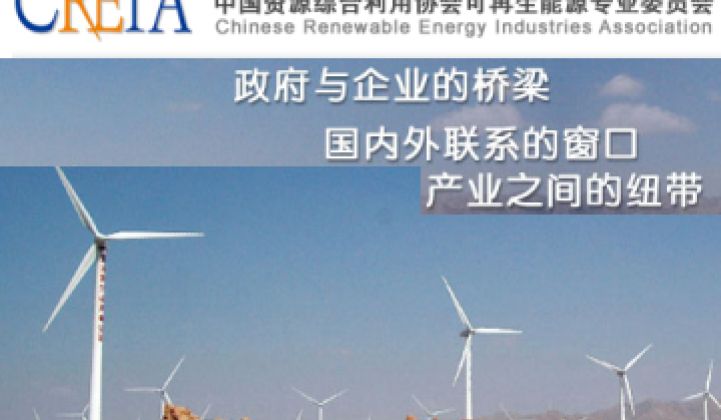China built its first wind farm in 1986 in Shandong Province. Its 1996 Ride the Wind program allowed wind farms to be built with up to 60 percent foreign materials.
By 2005, China’s leadership was putting more emphasis on renewable energy, went the historical narrative recounted in InfoCast’s “China's Participation in the US Wind Sector” webinar featuring Mitchell Silk, Jillian S. Ashley and Rebecca Perkins of the Allen & Overy LLP US-China Group and David Halligan, the Chief Financial Officer of Goldwind USA.
Also in 2005, the National Development and Reform Commission (NDRC) established a 70 percent local content requirement for Chinese wind farms that stood until 2009 and did what it was designed to do before U.S. pressure forced the government to replace the domestic content requirement with incentives and subsidies.
China’s installed wind capacity grew 64 percent in 2005, but that was just a hint of what was to come. It grew 105 percent in 2006, 127 percent in 2007, 106 percent in 2008, and 113 percent in 2009.
In 2009, wind turbines put to work in China averaged 95 percent locally manufactured content. In 2010, China’s new installed capacity was approximately equal to that of the rest of the world.
In the same period, China’s wind manufacturing capacity was growing even faster. Its share of the domestic market went from 21.1% in 2005 to 87.7% in 2009.
It is easy to guess the benefits of such growth, but there were also less expected consequences. China’s wind energy-generated electricity supply outstripped its grid’s capability. Though the government is driving an aggressive transmission build-out, China Grid’s capability remains inadequate.
Domestic competition created downward pressure on prices. Turbine prices fell from 6,500 to 8,500 RMB per kilowatt-hour in 2007 to 4,500 to 6,000 RMB per kilowatt-hour in 2010. More significantly, narrowing margins forced manufacturers to streamline production lines and look to other markets.
By 2010, 86 Chinese turbine makers had captured almost half of the world’s $45 billion turbine market and two, Sinovel and Dongfang, had moved into the top tier of world turbine makers.
Chinese manufacturers moved on Europe’s exploding, feed-in tariff (FIT)-driven markets, especially those in Germany, Spain and Italy. With the onset of the worldwide financial crisis at the end of 2008, Europe demand cooled and stabilized as the trouble-beset governments reeled in their incentives. But by then, Chinese manufacturers had already begun looking toward the amber fields of grain.
In 2009, the U.S. outlook was promising for wind and the other renewables. The American Recovery and Reinvestment Act (ARRA) provided big support against the recession and, with Democrats in control of the White House and both houses of Congress, a national Renewable Electricity Standard (RES) and other long-term policies seemed likely.
Things didn’t work out quite as planned.
From the Chinese manufacturers’ point of view, the U.S. market remains underdeveloped. They expect today’s approximately 40-gigawatt installed capacity to reach 300 gigawatts by 2030, driven by a variety of incentives, state standards and utilities’ need for reserve capacities. There is also every expectation that sooner or later federal leaders will institute a national standard and long-term tax credits.
China’s initial intentions met their first serious setback in 2009 when an announced Texas project to be financed largely by Chinese banks fell under scrutiny. There were invalid claims that ARRA taxpayer money was going to Chinese companies. Eventually, the A-Power project obtained additional funding from China banks, struck a deal with the United Steelworkers (USW) to use domestic steel, and continues to move slowly forward.
Another unresolved conflict is the USW complaint to the U.S. Trade Representative that China’s expansive support of its renewables sector constitutes an unfair trade advantage and a potential violation of World Trade Organization (WTO) rules.
China’s position is that the USW complaint is an obstacle to the vital growth of the world’s renewables capacity. At the same time, China recently announced a $6.2 billion dollar investment in U.S. companies to soothe the raging.
At present, six Chinese manufacturers have turbines in three U.S. wind farms and only A-Power has announced intentions to build a U.S. plant.
There remain two significant barriers to a Chinese move into U.S. wind. First, U.S. bank financing is hard for Chinese turbine manufacturers to obtain because of their limited track record here. That Chinese turbines sell at two-thirds the price of their competitors is not enough for banks to take the risk. Second, U.S. wind projects are driven by taxpayer-funded incentives and channeling those into Chinese companies remains unpopular.
Chinese manufacturers have solutions. They have access to government-backed banks’ financing and those banks are flush with U.S. cash. Then, Chinese manufacturers, confident of the quality of their machines, provide warranties -- some with special provisions, guarantees and credit arrangements -- to investors. Finally, the turbine makers are learning to take shares of the projects themselves, either in the form of cash grants or more traditional tax credits.
Chinese companies with solid financing currently available to them include Baoding Huide, Goldwind, A-Power, Baoding Tianwei, Miongyang, Sinovel, XEMC, and CSIC Haizhuang.
None of the obstacles to China’s advance on U.S. wind, largely the result of a very rapid emergence, are without solutions. Getting into the U.S. market is vital to the survival of the vibrant, competitive Chinese turbine makers and, according to the webinar’s longtime China watchers, the companies have the creativity and agility to adapt successfully.



